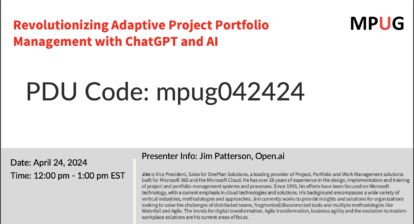 This interview with Benoit De Grace of Corporate Education Group, took place during the 2017 PMI® PMO Symposium® and was conducted and condensed by Kyle Brownell.
This interview with Benoit De Grace of Corporate Education Group, took place during the 2017 PMI® PMO Symposium® and was conducted and condensed by Kyle Brownell.
Q. This event focused on two key topics: Agile transformation and the evolving PMO. Can you speak to the importance of those topics for PMOs today?
A. In today’s economy, things are changing so rapidly that organizations have no choice, but to adapt. Agile is certainly one philosophy—an approach to changing an organization in such a way that it can adapt to this evolving environment. But, what I always question is whether human beings are able to adapt at such a pace? It’s great to have processes, technologies, methodologies, and Agile approaches, and there’s no doubt that organizations have to change, evolve, and transform themselves to meet the needs of the ever-changing world that we live in, but will people be able to follow the pace? That’s a question I think that we have to ask ourselves from time to time.
Q. Your organization sponsored an excursion to the Johnson Space Center, which you attended. Can you to tell us a little about that trip?
A. Yes, it was an amazing event. I think some people didn’t quite realize that we were not going to the space center, which was called ‘the amusement park’ by someone on the bus, but that we were actually going to the facility where the mission control center is located. We got to see the current mission control center that’s in operation today, and the one that they used back in the 60’s—the one that everyone probably saw in movies. Seeing both was actually one of the most interesting things. The current mission control has full color computer screens and all the high-tech stuff. It was occupied with a flight director that was sitting there monitoring the International Space Station and the mission they have currently going on … with lots of activity on the floor.
They also showed us the old one, which was completely deserted. It was really just a museum piece, at best. But one of the flight directors that was accompanying us on the tour pointed out that the old mission control center was very much hierarchical in its layout. In contrast to the current one, which is laid out on one level, the desks and the stations were laid out from top to bottom. In the old control center, we noticed the flight director’s seat was at the very top of the room and that progressively lesser skilled individuals were placed down at the bottom of the auditorium style set up.
Our tour guide commented that this was a reflection of how NASA had evolved over the years from a very top down organization to an organization that’s a lot flatter. There’s not so much hierarchy anymore, and I think that’s just in line with the idea of Agile transformation. It’s about empowering people and leaders to play very different roles than what they were expected to do back in the 60’s and 70’s. Seeing that, to me, was one of the highlights.
Q. Were there any discussions or references to NASA’s Project Management for past missions?
A. There were a lot of discussions that tied back to project management. For instance, we covered the topic of risk management. At one point while we were in the mission control center, someone mentioned an incident that took place during one of the shuttle landings. They had a bird strike during decent. It was a “one in a million” chance type of a thing, but even so, the crew that was flying the shuttle had actually prepared for such an event. They had practiced in the simulator, and because they practiced, they were able to land the shuttle safely. It got us into a discussion on risk management and project management because as project managers, we always wonder how much risk to safeguard against and how much mitigation you want to put into your project. Here’s this one example where people’s lives were at stake, and they did go to the extent of preparing for such an event even though the chances were minimal of it happening.
The other application we looked at was an understanding of how budgets and funding play into the management of projects. Of course, when you’re talking about missions going to the moon or mars, you’re talking about projects that are going to span 10 – 30 years, and during that time, governments change. With every new government, budgets change or funds get cut, so you can’t really plan that far ahead when you’re in those kinds of environments. I think that the private sector also has that challenge because from one year to the next, budgets can shift, there can be a financial downturn, or, for example, the price of copper goes down and then your mining project goes out the window. The point is, we all have to deal with our various constraints. When it comes to project management, the value of looking how to transform and evolve is great. The trip to the Space Center certainly confirmed that, and it was interesting from a project management standpoint.
Related Content
Webinars (watch for free now!):
Tactical Guide for Building a PMO – How to Run a Successful PMO
Showing PMO Love Through Monitoring and Automation
Articles:
Top 10 Best Practices for Managing Project Schedules Within a PMO
Your Guide to PMOs
The Tactical Guide for Building a PMO – How to Shutdown a PMO







